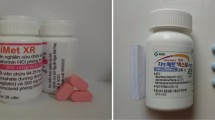Abstract
The primary objective of the present investigation was to formulate and evaluate fixed dose bilayer tablet of two antihyperglycemic agents with different mechanisms of action to improve glycemic control in patients with type 2 diabetes. A secondary objective is to ensure that metformin release should be less in stomach and completely released in alkaline pH within the stipulated hours. Hence, metformin hydrochloride (500 mg) sustained release (SR) layer was formulated using various release retardant polymers such as hydroxy propyl methyl cellulose, xanthan gum and sodium carboxy methyl cellulose in three different ratios of 1:0.3, 1:0.4 and 1:0.5, such that therapeutically effective levels can be maintained. Immediate release (IR) layer of pioglitazone hydrochloride (15 mg) was formulated using super disintegrant (crosspovidone) in four different ratios of 1:0.2, 1:0.4, 1:0.6 and 1:0.8. The formulated fixed dose bilayer tablets were subjected to various physiochemical evaluations like weight variation, friability, hardness, drug content, in vitro drug release kinetics and stability studies. The optimized formulation (F8) showed the maximum drug release up to 60 min in IR layer and up to 12 h in SR layer. Formulation F8 was found to be stable at room temperature for a period of 3 months. From the study it is evident that a promising bilayer tablet of pioglitazone hydrochloride and metformin hydrochloride can be developed using crosspovidone (disintegrant) and xanthan gum (release retardant polymer).




Similar content being viewed by others
References
Ajaykumar B, Sridivya G, Narendrababu NV, Reddi L, Ujvala K, Sekhar CB, Chandra R (2012) Formulation and evaluation of secnidazole conventional tablets by direct compression method. Int J Pharm Biol Sci 2(3):364–371
Akhilesh T, Mahatma OP, Joshi M (2013) Formulation and evaluation of combined floating bilayer tablet of metformin, pioglitazone and glimepiride. Int J Pharm Biol Arch 4(4):792–799
Alderman DA (1984) A review of cellulose ethers in hydrophilic matrices for oral controlled-release dosage forms. Int J Pharm Technol Prod Manuf 5:1–9
Alton ME (2002) Pharmaceutics the science of dosage form design, 2nd edn. Churchill Livingstone, Edinburgh
Ansel HC, Popovich NG, Allen LV (2011) Ansel’s pharmaceutical dosage forms and drug delivery systems, 9th edn. Lippincott Williams and Wilkins, London
Bagyalakshmi J, Phani Krishna Y, Ravi TK (2011) Bilayer tablet formulation of metformin hydrochloride and glipizide: a novel approach in the treatment of diabetes. Int J Pharm Sci Rev Res 8(2):35
Baveja SK, Hassan AU, Singh A (1989) Zero-order release of pseudoephedrine hydrochloride from matrix tablets. Indian J Pharm Sci 51:248–251
Defang O, Shufang N, Wei L (2005) In vitro and in vivo evaluation of two extended release preparations of combination metformin and glipizide. Drug Dev Ind Pharm 31:677–685
Galeone F, Fiore G, Arcangeli A, Mannucci E (1998) Gliclazide and metformin combination in patients with type 2 diabetes, preliminary data. Minerva Endocrinol 23:71–75
Hemanth Kumar G, Jaganathan K, Sambath Kumar R, Perumal P (2012) Formulation and in vitro evaluation of bilayer floating tablets of metformin hydrochloride and sitagliptin phosphate. Int J Adv Pharm 2(2):64–81
Jitendra RA, Mohan GK, Shrivastav VG, Yeole PG (2009) Bilayer tablet formulation of metformin hydrochloride and gliclazide: a novel approach in the treatment of diabetes. Int J Pharm Res Dev 1:1–11
Korsmeyer WR, Peppas NA (1981) Macromolecular and modeling aspects of swelling-controlled systems. In: Roseman TJ, Mansdorf SZ (eds) Controlled release delivery systems. Marcel Dekker, New York, pp 77–90
Kranthi Kumar K, Narasimha Reddy M, Kishore RN (2013) Formulation and evaluation of bilayer matrix tablet of pioglitazone HCl metformin HCl USP 15 mg and 500 mg. Asian J Pharm Clin Res 6(3):13
Lee PL, Kim CJ (1991) Probing the mechanism of drug release from hydrogels. J Control Release 16:229–236
Natarajan R, Vaishnani R, Rajendra NN (2011) Formulation and evaluation of immediate release tablets of paroxetine HCl using different superdisintegrants. Int J Res Pharm Biomed Sci 2(3):1095–1099
Patel JS, Divya T, Patel KN, Patel KJ (2013) A review on bilayer tablets. J Drug Discov Ther 1(3):40–48
Peppas NA, Sahlin JJ (1989) A simple equation for the description of sustained release. III Coupling of diffusion and relaxation. Int J Pharm 57:169–172
Ramesh S, Sathish Kumar D, Guruvaiah B, Harini A (2010) Formulation and evaluation of bilayered sustained release matrix tablets of metformin HCl Sr and pioglitazone. Am Eurasian J Sci Res 5:176–182
Reynolds TD, Gehrke SH, Hussain AS (1998) Polymer erosion and drug release characterization of hydroxypropylmethyl cellulose matrices. J Pharm Sci 87:1115–1123
Ritger PL, Peppas NA (1987) A simple equation for description of solute release II Fickian and anomalous from swellable devices. J Control Release 5:37–42
Sadhana S, Shivanikar S, Zadbuke N, Padalkar A (2012) Formulation and evaluation of bilayered tablet of metformin hydrochloride and pioglitazone hydrochloride. Int J Pharm Pharm Sci 4(5):12
Sandhya P, Faheem UB, Afreen B (2014) Formulation and evaluation of bilayer tablets of glimepiride and metformin HCl. IOSR J Pharm Biol Sci 9(1):38–45
Sonar SG, Jain DK, More DM (2007) Preparation and in vitro evaluation of bilayer and floating-bioadhesive tablets of rosiglitazone maleate. Asian J Pharm Sci 2(4):161–169
Uttam M, Tapan KP (2008) Formulation and in vitro studies of a fixed-dose combination of a bilayer matrix tablet containing metformin HCl as sustained release and glipizide as immediate release. Drug Dev Ind Pharm 34(3):305–313
Acknowledgments
All the authors declare that they have no conflict of interest. The article does not contain any studies relating use of animal and human subjects performed by any of authors. The authors would like to express their gratitude to Spectrum Pharma Labs, Hyderabad, India for performing the FTIR analysis.
Author information
Authors and Affiliations
Corresponding author
Rights and permissions
About this article
Cite this article
Prasanthi, B., Shilpa, K.S.K., Nagabhushana Rao, M. et al. Design and evaluation of bilayer tablets of metformin hydrochloride and pioglitazone hydrochloride as combination drug therapy. Journal of Pharmaceutical Investigation 47, 497–505 (2017). https://doi.org/10.1007/s40005-016-0276-6
Received:
Accepted:
Published:
Issue Date:
DOI: https://doi.org/10.1007/s40005-016-0276-6




